From the serene banks of Lake Erie to the rolling hills of Appalachia, Ohio’s diverse landscapes are a haven for a myriad of bird species. Among these feathered residents are stunning orange-hued birds that add a burst of color to the state’s avian tapestry.
Dive into this guide to explore nine mesmerizing orange birds that grace Ohio with their presence, and don’t miss the accompanying free photo guide to enhance your birdwatching journey. Whether you’re a seasoned birder or just starting out, the beauty of these birds will surely captivate your heart.
Orange Birds Found In Ohio
The geographical positioning of Ohio, combined with its varied habitats, creates an avian paradise. Its expansive deciduous forests, sprawling grasslands, wetlands, and significant portion of the Lake Erie shoreline provide diverse habitats that cater to a myriad of bird species. The mix of habitats, combined with its strategic location, ensures that Ohio remains a hotspot for both resident and migratory birds, making it a haven for birdwatchers.
Baltimore Oriole


| Feature | Measurement |
|---|---|
| Scientific Name | Icterus galbula |
| Length | 6.7–8.7 in |
| Wingspan | 9.1–12.6 in |
| Weight | 22.3-42 g |
The Baltimore Oriole is a stunning bird, best known for its vibrant coloration and its rich, whistling song.
Appearance: The male Baltimore Oriole is notable for his bright orange and black plumage and black and white wing bars, a stark contrast to the more muted yellow-brown coloration of the female. Both sexes, however, have long pointed bills and white bars on their wings.
Diet: Baltimore Orioles have a diverse diet that includes insects, fruits, and nectar. Their preference for sweet juices and fruit pulp often brings them to backyard feeders offering oranges and jelly.
Reproduction: The female Baltimore Oriole is responsible for building the distinctive hanging nest, often woven together from fine materials like hair and grass. These nests are usually high in trees to avoid predators. The female lays 3-7 eggs, which are incubated for about two weeks.
Northern Oriole
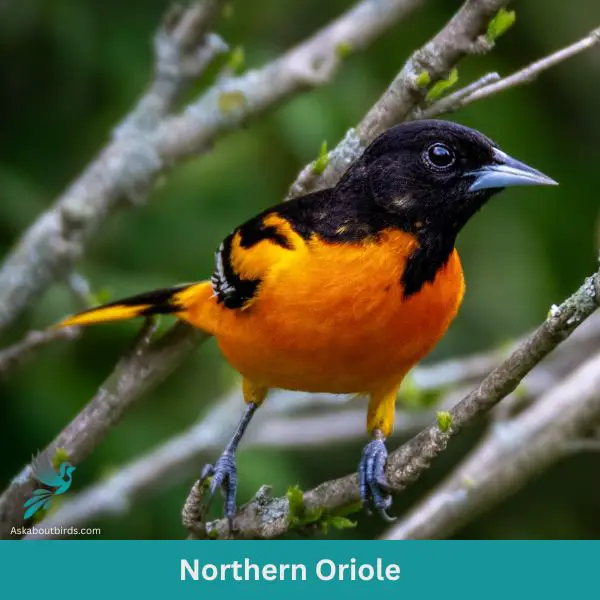

| Feature | Measurement |
|---|---|
| Scientific Name | Icterus galbula |
| Length | 7–8 inches |
| Wingspan | 11-12 inches |
| Weight | 1.0–1.4 oz |
The Northern Oriole is a brightly colored bird known for its striking orange and black plumage, melodic songs, and agile movements as it flits among tree branches.
Appearance: The Northern Oriole showcases a vivid orange underbelly, contrasting sharply with its black head, back, and wings. Males tend to be more vibrantly colored than females, but both genders display white wing bars.
Diet: Northern Orioles have a varied diet comprising insects, fruits, and nectar. They are particularly fond of caterpillars, beetles, and spiders, and during migration, they often forage on fruits like berries.
Reproduction: Building pendulous, sock-like nests on the ends of tree branches, the female Northern Oriole lays a clutch of 3 to 7 eggs. The nests are often carefully woven with hair, grasses, and other plant materials, providing protection for the young chicks.
Barn Swallow

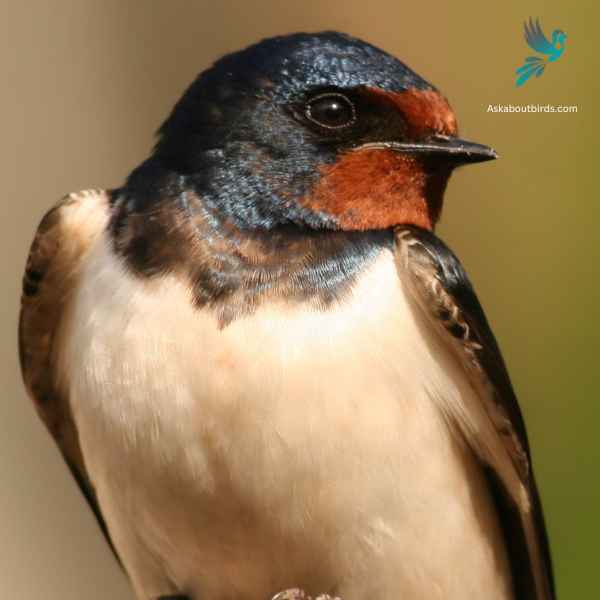
| Feature | Measurement |
|---|---|
| Scientific Name | Hirundo rustica |
| Length | 6.5–7.5 in |
| Wingspan | 12.5–13.5 in |
| Weight | 16–22 g |
The Barn Swallow is a sleek, agile bird renowned for its graceful flight patterns and iconic forked tail, often seen darting over fields and water bodies in search of flying insects.
Appearance: Barn Swallows have deep blue, almost iridescent, upperparts and a rufous to tawny underbelly. Their distinctively forked tail and long wings give them a streamlined look. Both males and females have a similar appearance, though males often exhibit slightly brighter colors and a deeper fork in the tail.
Diet: Barn Swallows feed primarily on flying insects, which they catch in mid-air during their agile and acrobatic flights. Their diet includes flies, beetles, moths, and other small flying insects.
Reproduction: Barn Swallows are known for building their mud nests on man-made structures, particularly barns, bridges, and eaves. The nest is cup-shaped and made from mud pellets, often lined with feathers. The female lays a clutch of 4 to 6 eggs.
American Robins


| Feature | Measurement |
|---|---|
| Scientific Name | Leptotila plumbeicep |
| Length | 10.6-11.8 in |
| Wingspan | — |
| Weight | 160-200 g |
The American Robin is a widely recognized bird species known for its melodious song and early bird tendencies.
Appearance: American Robins are medium-sized birds with a distinctive appearance. Both males and females sport a gray to brown back and a warm red to orange breast and belly and gray wings. They also have a characteristic white eye-ring and a black head, but males are usually darker than females.
Diet: American Robins have a diverse diet that changes depending on the season. In summer, they feed heavily on earthworms, beetles, and other invertebrates, which they catch on the ground. During winter, they mostly eat fruits and berries.
Reproduction: American Robins usually build their nests in trees or shrubs, but they are also known to nest on human-made structures. The female lays a clutch of about 3 to 5 eggs, which she incubates for about 12 to 14 days.
American Redstart


| Feature | Measurement |
|---|---|
| Scientific Name | Setophaga ruticilla |
| Length | 4.3 to 5.5 in |
| Wingspan | 6.3 to 9.1 in |
| Weight | 8.6 g |
The American Redstart is a lively warbler known for its vivid colors and active hunting style, often seen flitting about, fanning its tail to startle and catch insects.
Appearance: Adult male American Redstarts boast striking black plumage with bright orange patches on the sides, wings, and tail. Females and immature males have grayish-olive upperparts with yellow patches in the same areas where the males display orange.
Diet: American Redstarts are primarily insectivores. They actively forage for flying insects, as well as caterpillars and spiders, often using their colorful tails to startle prey and make them easier to catch.
Reproduction: The female American Redstart builds a cup-shaped nest in the fork of a tree branch. Typically, she lays a clutch of 3 to 5 eggs. The female takes on the primary responsibility of incubating the eggs, while both parents participate in feeding the fledglings after they hatch.
Northern Flicker

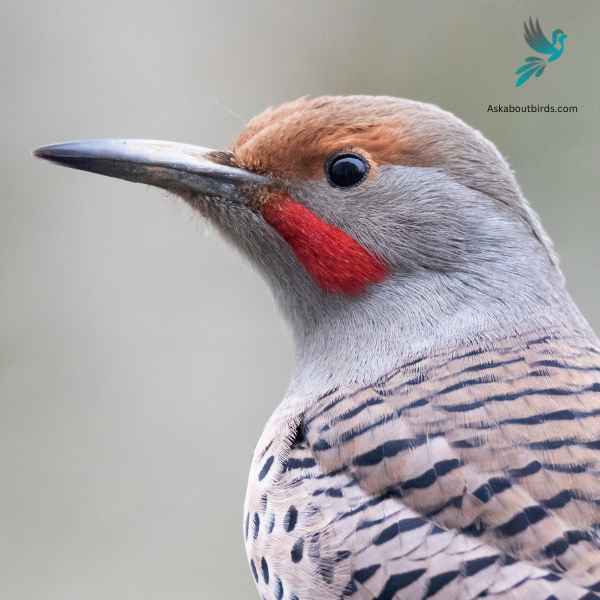
| Feature | Measurement |
|---|---|
| Scientific Name | Colaptes auratus |
| Length | 11–12 in |
| Wingspan | 17–20 in |
| Weight | 3.9–5.6 oz |
The Northern Flicker is a medium-sized woodpecker, recognized by its unique patterns and coloring, often found drumming on trees or foraging on the ground across North America.
Appearance: The Northern Flicker stands out with its grayish brown body, black-scalloped plumage, and a black bib. Males sport a distinctive black or red mustache stripe. Depending on the subspecies, the underwing and undertail feathers can be bright yellow or red, flashing vividly during flight.
Diet: While most woodpeckers are tree-bark foragers, the Northern Flicker prefers hunting on the ground. Its primary diet consists of ants and beetles, supplemented occasionally by fruits, berries, seeds, and other small insects.
Reproduction: Northern Flickers are cavity nesters, preferring to excavate their nesting hole in dead or diseased tree trunks. The interior of the nest is lined with wood chips.
Eastern Towhee

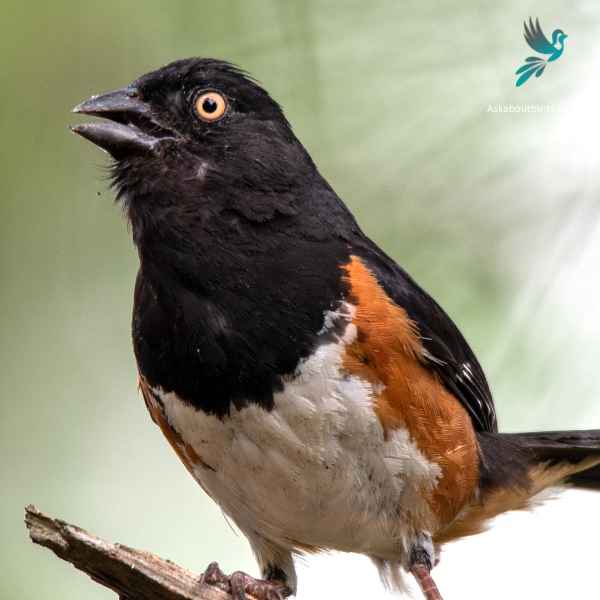
| Feature | Measurement |
|---|---|
| Scientific Name | Pipilo erythrophthalmus |
| Length | 6.8 to 9.1 in |
| Wingspan | 7.9–11.8 in |
| Weight | 32 to 53 g |
The Eastern Towhee is a distinctive songbird known for its unique calls and eye-catching coloration.
Appearance: Male Eastern Towhees are characterized by a striking combination of a black head, back and tail, contrasting with a white belly and rufous flanks. Females sport similar patterns but instead of black, they have a rich brown color. Both genders have red eyes, lending a special charm to their overall appearance.
Diet: Eastern Towhees primarily feed on a variety of insects, seeds, and berries. Their diet is quite diverse, taking advantage of seasonal offerings, which includes beetles, caterpillars, spiders, acorns, grass seeds, and various fruits and berries.
Reproduction: Eastern Towhees build their nests on or near the ground, often in a shrub or a small tree. The female lays around 3-5 eggs and takes the primary role in incubating them over about 12-13 days.
Red-breasted Nuthatch

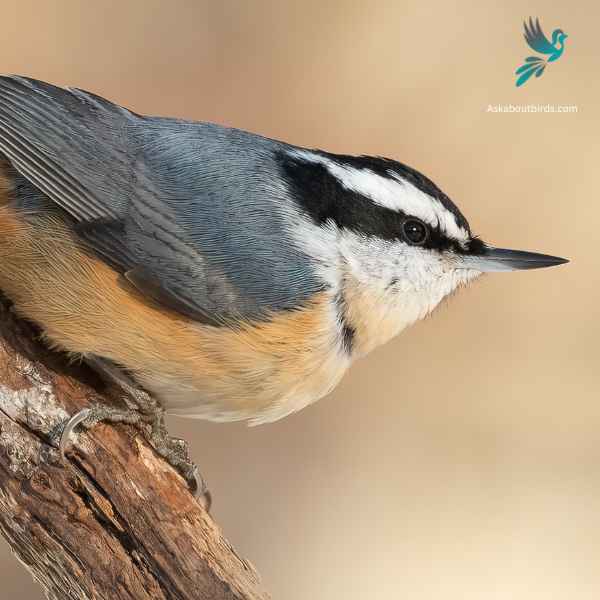
| Feature | Measurement |
|---|---|
| Scientific Name | Sitta canadensis |
| Length | 4.3–4.7 in |
| Wingspan | 8.3 in |
| Weight | 0.3–0.5 oz |
The Red-breasted Nuthatch is a small, agile songbird, known for its ability to move headfirst down tree trunks while searching for food.
Appearance: This bird boasts a slate-blue back and a pale rust-red underside. A prominent black stripe runs through the eye and is bordered above by a white eyebrow. Their sharp, pointed bill is characteristic of the species.
Diet: Red-breasted Nuthatches primarily feed on insects and seeds, especially those from coniferous trees. They have a fondness for large seeds, which they wedge into bark crevices to hack open with their bills.
Reproduction: These birds construct nests in natural tree cavities or abandoned woodpecker holes, often lining the entrance with resin. This is thought to deter predators or competitors from entering. The female typically lays a clutch of 5 to 6 eggs, and both parents partake in feeding the chicks once they hatch.
Orchard Oriole
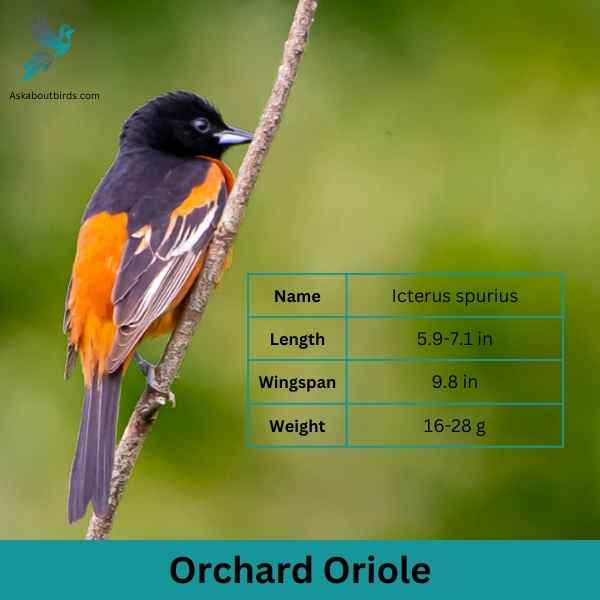
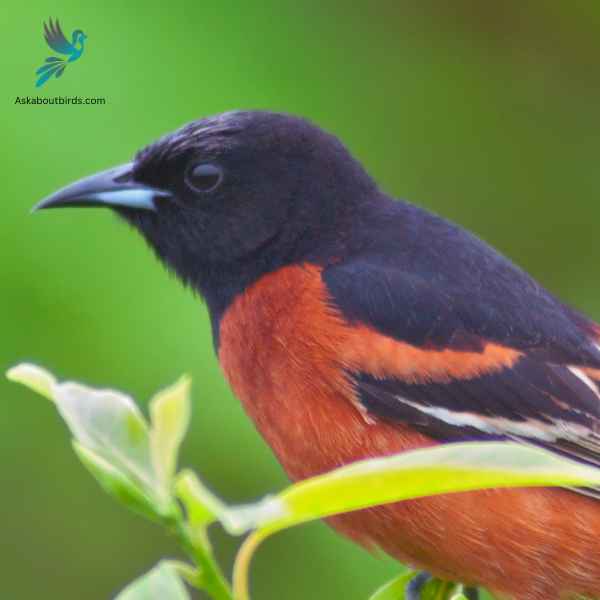
| Feature | Measurement |
|---|---|
| Scientific Name | Icterus spurius |
| Length | 5.9-7.1 in |
| Wingspan | 9.8 in |
| Weight | 16-28 g |
The Orchard Oriole is a small songbird noted for its distinctive coloration and melodic song.
Appearance: Male Orchard Orioles are a striking sight with their dark chestnut body and black head and black and white wings, while females and immature males are olive-green and feature a yellowish underpart. The species is often recognized by its slender body and pointed bill.
Diet: The diet of the Orchard Oriole consists primarily of insects, fruits, and nectar. They are adept at catching insects mid-air and are also known to sip nectar from flowers, aiding in pollination. When fruits are in season, they make up a substantial portion of the bird’s diet.
Reproduction: Orchard Orioles often nest in open woodlands and orchards, hence their name. The female is responsible for building the nest, typically choosing a location in a tree or shrub. The female lays a clutch of 4 to 6 eggs, which she incubates for about two weeks.
House Finch


| Feature | Measurement |
|---|---|
| Scientific Name | Haemorhous mexicanus |
| Length | 5–6 in |
| Wingspan | 8–10 in |
| Weight | 0.6–0.9 oz |
The House Finch is a small songbird widely distributed across North America and is commonly found in urban and suburban areas.
Appearance: Males of this species are brightly colored with crimson faces and throats, which can extend to the chest and back, while their flanks have streaks. The female is streaked brown and lacks the red coloring. Both have a square-tipped tail and a distinctively long, flat-topped bill.
Diet: House Finches primarily eat seeds, grains, and berries. They have a particular fondness for sunflower seeds and can be commonly seen at bird feeders. Occasionally, they will also consume insects, especially during the breeding season.
Reproduction: House Finches are cavity-nesters and might choose ledges, vents, ledges, and other urban settings. They might also utilize trees or shrubs. Their nests can be made of a wide array of materials, from feathers to twigs.
Blackburnian Warbler
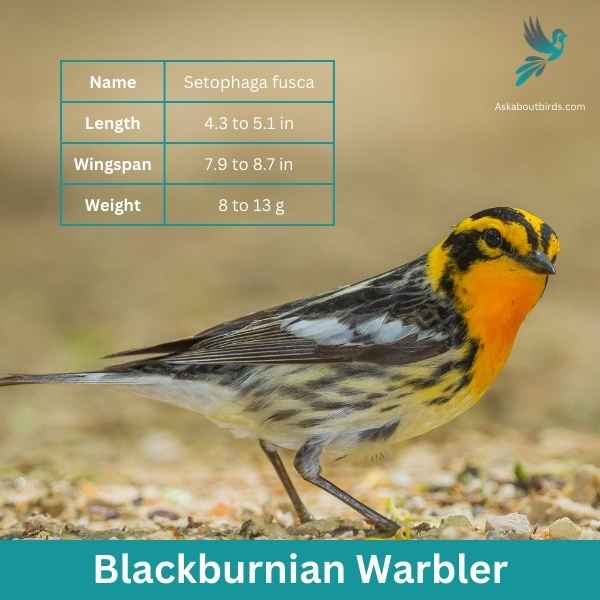

| Feature | Measurement |
|---|---|
| Scientific Name | Setophaga fusca |
| Length | 4.3 to 5.1 in |
| Wingspan | 7.9 to 8.7 in |
| Weight | 8 to 13 g |
The Blackburnian Warbler is a strikingly colored songbird that captivates observers with its vivid plumage, especially during the breeding season. Often found flitting high in the treetops of North American forests, its melodious song is as enchanting as its appearance.
Appearance: Male Blackburnian Warblers are distinguished by their fiery-orange throats, contrasting sharply with a black face, crown, and streaked back. They also have white underparts with black streaks on the sides. Females have a more muted coloration, with a yellowish or pale orange throat and less pronounced streaking.
Diet: Blackburnian Warblers primarily feed on insects and spiders. They are adept at foraging in the canopy, where they glean insects from the surface of leaves and branches or catch them mid-air in quick, agile flights.
Reproduction: Blackburnian Warblers build their nests high up in coniferous trees, often on horizontal branches. The nest is a neat cup made of twigs, grass, and moss, lined with softer materials like hair or feathers. The female lays a clutch of 4 to 5 eggs and takes the lead in incubation.
Where to Spot Ohio’s Orange Birds
Ohio’s diverse landscapes offer birdwatchers a unique opportunity to observe a myriad of avian species, especially those with vibrant orange plumages. Here are the top locations in the state to experience the wonder of birdwatching:
- Magee Marsh Wildlife Area: Located on the southern edge of Lake Erie, this marsh is renowned as a migratory hotspot, especially during spring. Its boardwalk offers unbeatable views of warblers, orioles, and other songbirds.
- Cuyahoga Valley National Park: With a blend of forests, wetlands, and grasslands, this national park is a haven for diverse bird species. The towpath trails are particularly popular among birders seeking thrushes, tanagers, and flycatchers.
- Ottawa National Wildlife Refuge: Situated near Lake Erie, this refuge provides crucial habitats for waterfowl and wading birds. It’s an excellent spot for viewing shorebirds and marsh birds, with orioles and tanagers frequenting the surrounding woodlands.
- Shawnee State Forest: Located in the Appalachian foothills, this vast forest is home to a rich array of songbirds. Its dense woodlands and clearings attract tanagers, woodpeckers, and the occasional migrating warbler.
- Oak Openings Preserve: A unique blend of sand dunes, prairies, and forests, this site in Northwest Ohio is a biodiversity hotspot. Its distinct habitats make it a prime location for spotting a diverse range of birds, from sparrows to orioles.
| State’s Orange Birds | Best Spots for Orange Birds |
|---|---|
| Indiana’s Orange birds | 1. Goose Pond Fish & Wildlife Area 2. Brown County State Park 3. Indiana Dunes National Park |
| Kentucky’s Orange birds | 1. Mammoth Cave National Park 2. Daniel Boone National Forest 3. Red River Gorge Geological Area |
| Michigan’s Orange birds | 1. Point Pelee National Park 2. Sleeping Bear Dunes National Lakeshore 3. Seney National Wildlife Refuge |
| Pennsylvania’s Orange birds | 1. Hawk Mountain Sanctuary 2. Presque Isle State Park 3. Allegheny National Forest |
| West Virginia’s Orange birds | 1. New River Gorge National Park and Preserve 2. Canaan Valley 3. Monongahela National Forest |
FAQs on Orange Bird Species Found in Ohio
What kind of bird has a bright orange beak in Ohio?
In Ohio, the Atlantic Puffin is known for its vivid orange beak. However, it’s crucial to note that Atlantic Puffins are primarily coastal birds found along the northeastern coasts, so sightings in Ohio would be exceptionally rare or off-course.
What bird is orange and black in Ohio?
The Baltimore Oriole is an orange and black bird commonly seen in Ohio. Males are particularly striking with bright orange plumage, undersides contrasted by a black head, back, and wings.
Are Orioles rare in Ohio?
Orioles, especially the Baltimore Oriole, are not rare in Ohio. They are regular summer residents, arriving typically in early May and departing by late September. They come to Ohio to breed and are commonly seen in gardens at the bird feeder, woods, and orchard. If you want them to visit bird feeders then put out nectar for them.
In Ohio, bird enthusiasts enjoy a delightful array of avian visitors and residents throughout the year. While most of the bird species found here are native to North America, some have connections to South America, migrating between the continents with the changing seasons.
A favorite among Ohioans is Northern Cardinals, a year-round resident that adds a splash of brilliant red to the winter landscape, making it one of the most beloved winter birds. Another striking sight is birds adorned with black wings, such as the Red-winged Blackbird, which also flaunts bright yellow feathered edges on its epaulets. These vibrant hues, whether from bright yellow feathers or the deep red of cardinals, serve as nature’s canvas, painting Ohio’s landscapes with remarkable beauty all year long.




